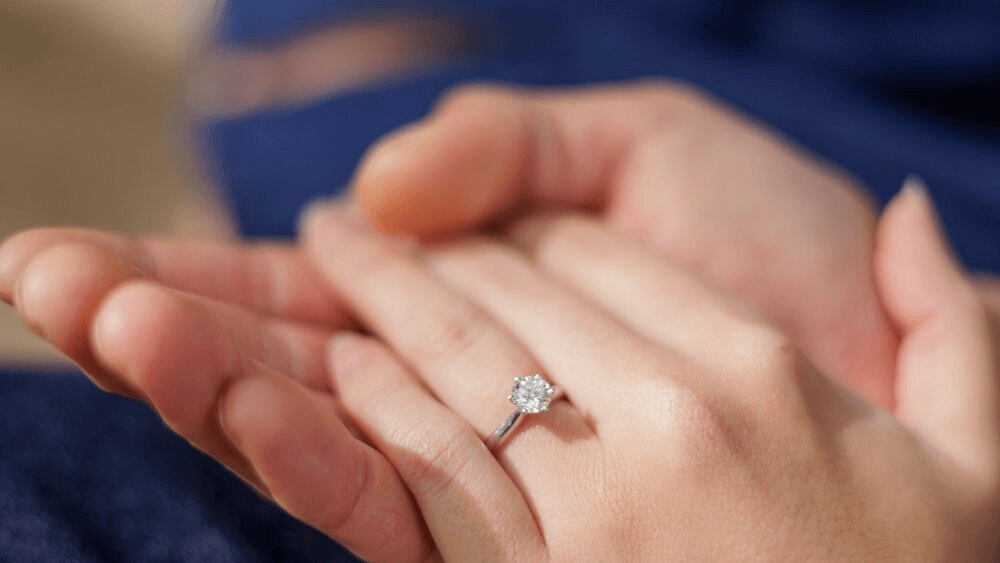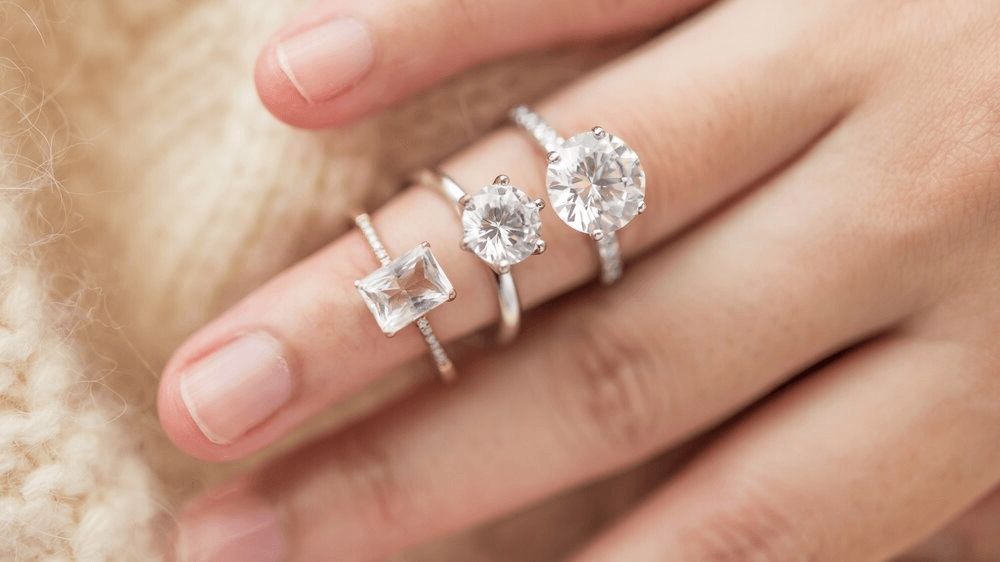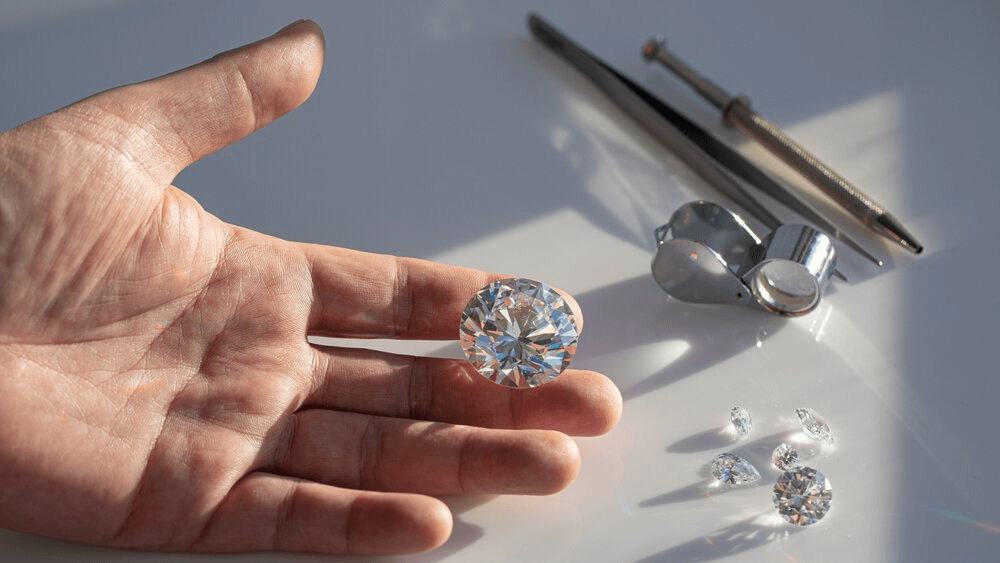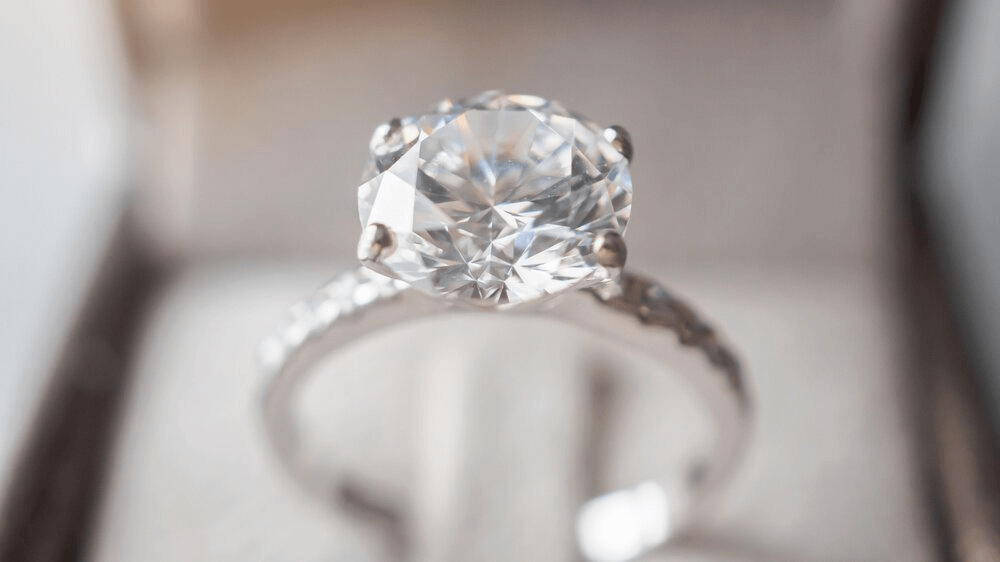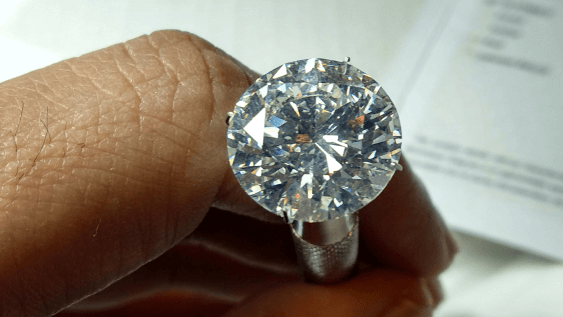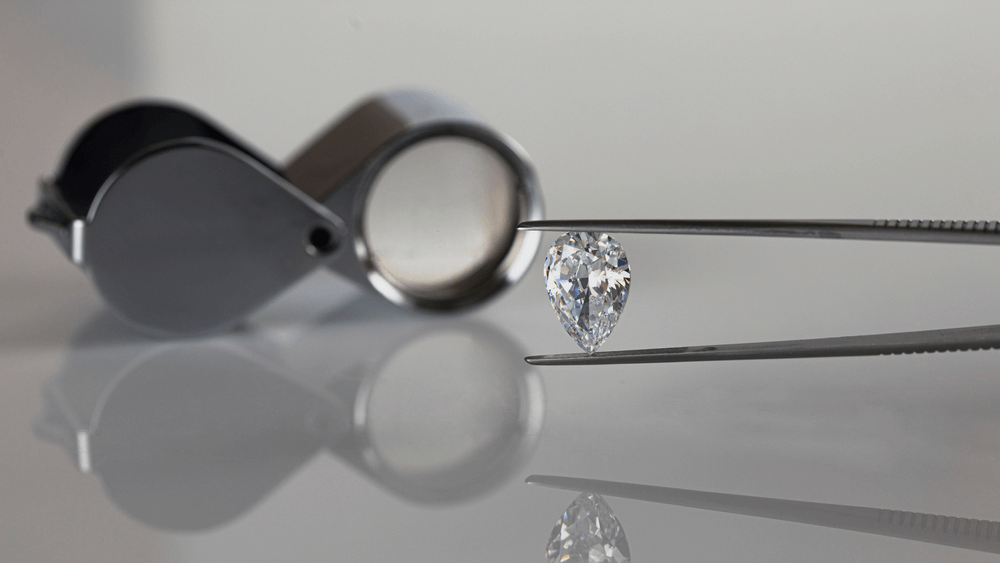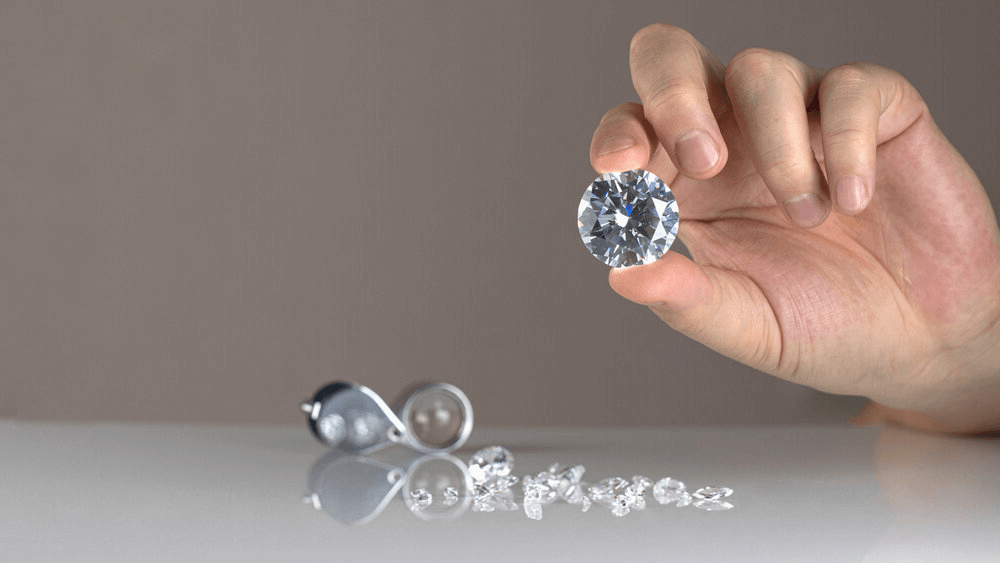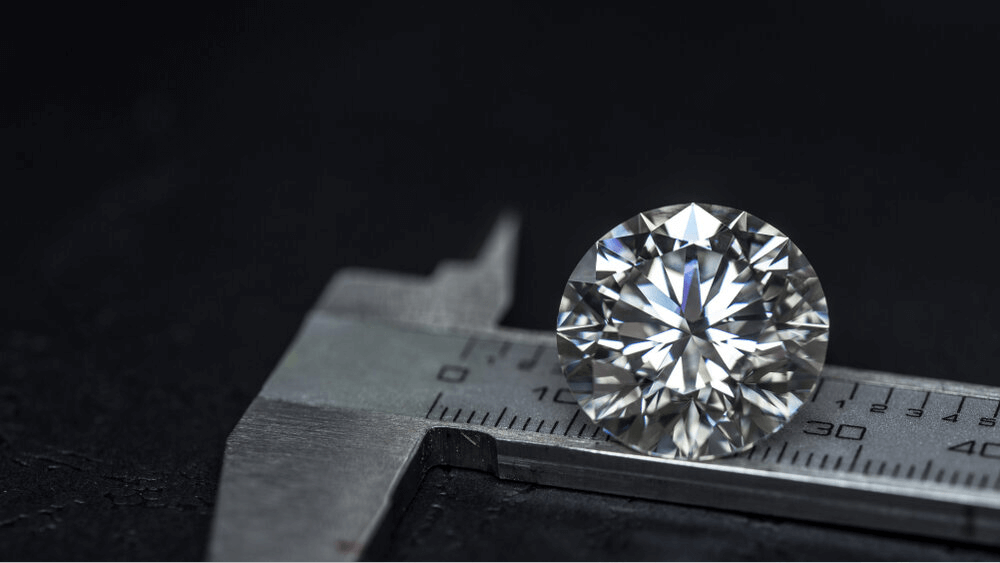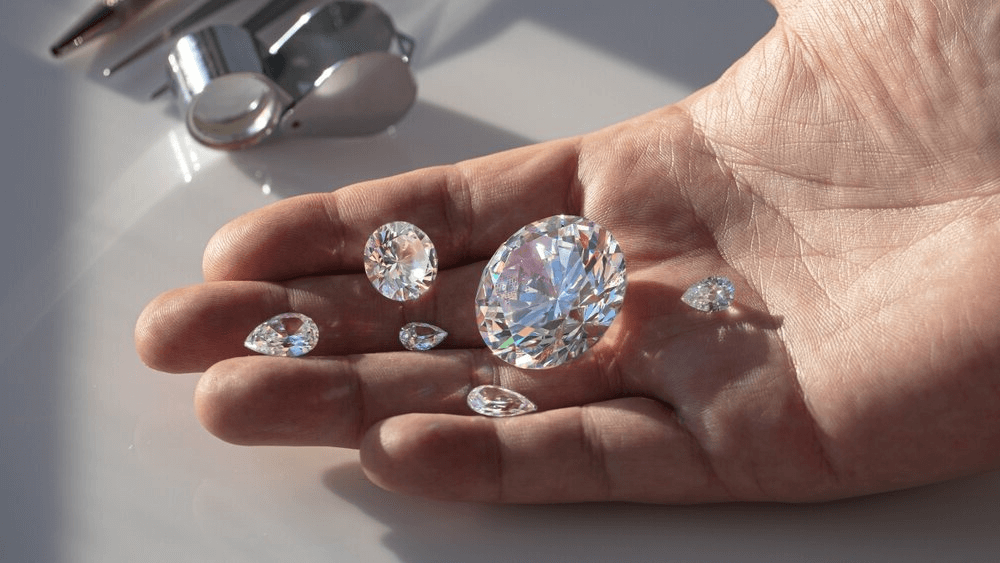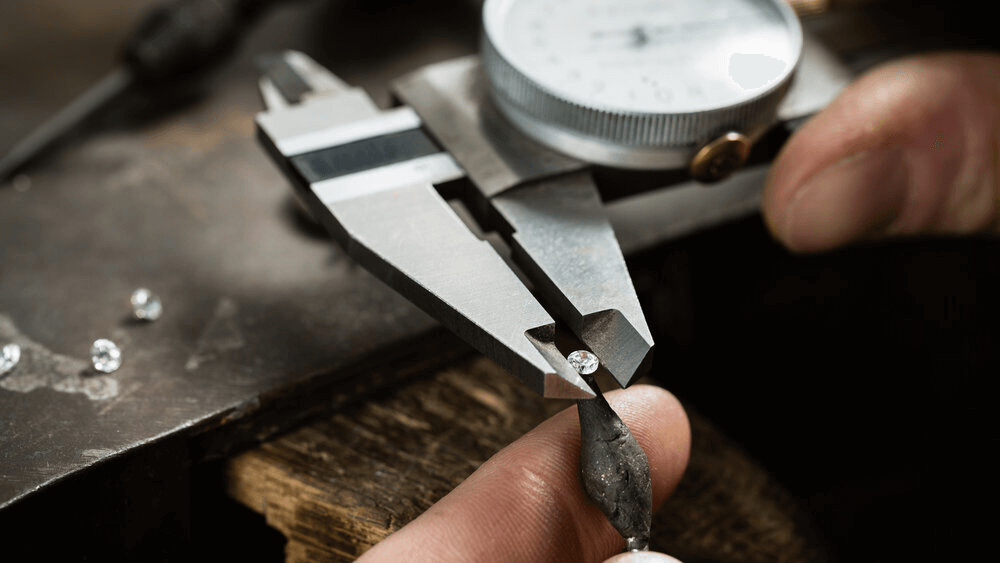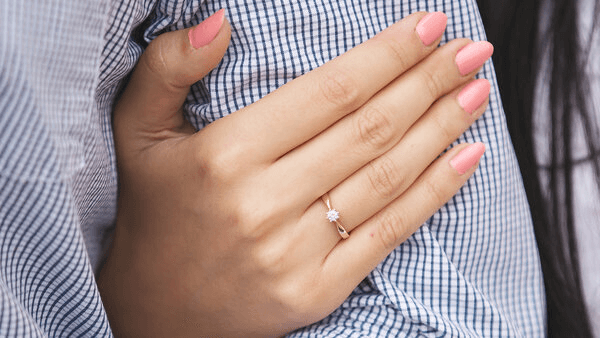7 Carat Diamond Rings: Affordable Luxury Prices Revealed

By Gary A.

Edited by Olivia H.
Published Aug 8, 2024
Edited on Jan 20, 2025
A 7-carat diamond is more than just a statement piece—it’s an extraordinary symbol of elegance and luxury that turns heads and captures hearts. Dive into our guide on 7-carat diamond rings to discover what makes them truly unforgettable.

Navigate This Guide:
- Eight Quick Tips for Purchasing a 7 Carat Diamond
- Introduction to 7-Carat Diamond Rings
- The Grandeur of Size and Sparkle
- Understanding the Value: The 4Cs Unveiled
- Price Dynamics of 7 Carat Diamond Rings
- Selecting the Perfect 7 Carat Diamond Ring
- The Impact of Certification and Authentication
- Our Expert Take
- 10 Frequently Asked Questions About 7 Carat Engagement Rings
Before we dive deeper into the specifics, here are some practical tips to help guide your decision-making process:
Eight Quick Tips for Purchasing a 7 Carat Diamond
- Tip 1: Physical Examination:
- Loupe Inspection: Always ask to view the diamond under a jeweler’s loupe. This will allow you to see any inclusions or blemishes up close.
- Side-by-Side Comparison: If possible, compare the 7-carat diamond side by side with another diamond of similar or slightly lesser quality. This can help you see differences in brilliance, clarity, and color more clearly.
- Tip 2: Ask for a Sarin Report:
- This is a detailed analysis of the diamond’s proportions. For large diamonds like a 7-carat, even slight variations in cut and proportion can significantly affect its brilliance and value.
- Tip 3: Mind the Setting:
- A larger diamond like a 7-carat can be more prone to getting knocked or chipped. Consider settings that protect the diamond, like a bezel or halo setting. Also, ensure the setting doesn’t hide too much of the diamond, as you’d want to showcase its size and brilliance.
- Tip 4: Negotiate the Price:
- Given the high value of a 7-carat diamond, there’s often room for negotiation. Don’t hesitate to ask for a better price or any ongoing promotions. Some jewelers might also offer a discount for cash payments.
- Tip 5: Check for Fluorescence:
- Diamonds can have a characteristic called fluorescence, which means they glow under UV light. While this isn’t necessarily a bad thing, strong fluorescence in a high-quality diamond can make it appear hazy or oily in sunlight. Ensure you check the diamond in natural light to see if this is the case.
- Tip 6: Consider Future Resale Value:
- If there’s a chance you might want to upgrade or trade in the diamond in the future, ask the jeweler about their policies. Some jewelers offer a full value trade-in or upgrade policy for diamonds purchased from them.
- Tip 7: Get an Independent Appraisal:
- After purchasing, it’s wise to get an independent appraisal, especially for a high-value diamond. This ensures you’ve received the quality you paid for and will be crucial for insurance purposes.
Now that you’ve got these practical tips, use Jeweler AI below to find the perfect engagement ring that suits your style and budget:
Introduction to 7-Carat Diamond Rings
It’s hard to explain exactly why, but every time we write a new diamond guide, the bigger the diamond gets, the more our heart rate seems to increase! That’s the excitement of buying a diamond like the 7 carat. While 5 carat diamonds or 6 carat diamonds are beautiful in their own right – it’s not all about the rock, we hasten to remind you – there’s something indescribably special about a 7 carat. Well, we say it’s indescribable, only we’re about to describe it!
The Grandeur of Size and Sparkle
Maybe it’s the sheer grandeur of the size and sparkle. When you wear a 7 carat diamond, you’re making a statement that is both bold and personal – bold due to the sheer, dazzling brilliance of the diamond itself, and personal due to the thought that has gone into purchasing such a rare, beautiful diamond as a statement of love. Buying a diamond like this is a once-in-a-lifetime purchase – something that will be loved from the moment it goes on the finger, and hopefully loved for generations beyond that moment.
Understanding the Value: The 4Cs Unveiled
No pressure in getting it right, then! While any 7 carat diamond is bound to be gorgeous, a lot of work still needs to be put into what kind of diamond you’re investing in. As ever, this falls back to the 4Cs. If you’ve checked out any of our other blogs, you might already be familiar with these factors, but just in case, we’re going to unveil them again – just scroll down a little bit if you’ve heard it all before!
Carat Weight: More Than Just Size
The first ‘C’ to think about is ‘Carat’ – what is the weight and why does it matter? If you don’t already know, a carat is a unit of weight used to measure diamonds, with one carat equaling 0.2 grams. With this in mind, there will be visual differences between each carat size – simply by looking at different diamonds such as 1 carat, 2 carat, and 7 carat, you’ll get a solid idea of how they compare in size and wow factor. This isn’t just about what looks more spectacular, however. Carat weight also carries a lot of symbolic value – it indicates luxury, status, and prestige, which some buyers would rather sacrifice for something more intricately brilliant. This is where the other three C’s come into play.
Clarity: The Beauty Within
When you’re looking at clarity, you’re looking at the presence – or absence – of internal inclusions and external blemishes. Have you ever sat in a restaurant and seen a woman’s diamond ring sparkle from across four tables? One of the reasons that’s happening is because there is little interference with the passage of light through the diamond – the more exceptional the clarity, the more fire and brilliance are on show. This also affects the durability of the diamond. If a diamond has significant inclusions, then it could be more prone to damage such as chipping or cracking – especially if the imperfections are located near the surface or along facets.
Color: The Hue of Luxury
Color is another important thing to consider. This refers to the presence – or absence – of color in the diamond, with the most valuable being entirely cololorless – or at least, exhibiting minimal coloration. Once again, this has a big impact on appearance and the ability for the diamond to sparkle. While a colorless diamond allows more light to pass through, a diamond with noticeable coloration will appear far less vibrant. To help in your choice, this is typically graded by the GIA – with the color scale ranging from D (colorless) to Z (light yellow or brown).
Cut: The Facets of Brilliance
The last ‘C’ to look into is the cut. This refers to the precision and craftsmanship with which the diamond has been shaped and faceted – from the rough diamond into a polished gemstone. The proportions taken into account here include the facets, angles, and overall shape – all of which will help to determine how effectively it interacts with light. Once again, this is graded by the GIA, which evaluates factors including brightness, fire, and scintillation, and then ranks them from ‘Excellent’ to ‘Poor’. the scale ranging from ‘Excellent’ to ‘Poor’
Price Dynamics of 7 Carat Diamond Rings
You might have been reading this blog and thinking: ‘come on, just get to the prices’. And to be honest, you’re not wrong. Your budget is going to be the most crucial factor in your diamond shopping, with most 7 carat diamond rings ranging – on average – anywhere from $50,000 to $600,000. That’s an incredibly pricey diamond, especially considering you can buy multiple 1 carat, 2 carats, or even 3 carat diamonds, and still have paid less than if you’d pay for a 7 carat.
The Cost Factor: Investment and Worth
But the thing about the 7 carat diamond is that it’s an investment. When you get to this kind of size carat, the diamond tends to appreciate in value over time, especially if it has a strong clarity, color, and cut grading. So while you’d be paying a lot of money, you might also be sitting on more money in the long run.
Navigating the Price Spectrum
When navigating the price spectrum, however, it’s important to think about what you want in a diamond, and what you’re willing to sacrifice on. As we mentioned before, the 7 carat is a big diamond that commands a sense of authority and prestige, but not everyone wants their diamonds to be so ‘out there’. If you were to go for a smaller 6 carat or even a 5 carat diamond, you’d be left with something more minimal, and perhaps more subtly beautiful. That is to say, while you might be able to afford a 7 carat diamond, you might have to sacrifice things like color, clarity and cut if you want to avoid going into the big triple zeros. For this reason, you might find it a better idea to go for something smaller in weight, but more powerful in its shine.
Selecting the Perfect 7 Carat Diamond Ring
This is your choice at the end of the day, and if you decide to go for a 7 carat diamond ring, it’s very likely that you won’t regret it. Before you make the purchase though, it’s important to take some time with your selection and take a few more factors into account.
Shape and Style: Personalizing Elegance
Ordinarily, when you’re looking at the shape of a diamond, you’re looking for something that can disguise its true size – for instance, if you’re purchasing a 2 carat diamond, you’ll be looking for a cut that amplifies its features and makes it look bigger than it really is. This isn’t something you have to worry about with the 7 carat range, because a 7 carat diamond is never going to look small! That being said, there are particular shapes that can give your diamond more of an impact and make it sparkle all the more. The oval and pear, for instance, can both offer a flattering silhouette when worn, and the symmetry of the round brilliant can give your diamond optimal light performance.
Setting the Stone: Security Meets Design
You should also factor in how the diamond itself is going to be set. This is all about doing the stone justice and giving it a home that compliments its elegance. The solitaire, halo, and three-stone setting are all strong contenders in this regard, and if you want to prioritise safety and security over anything else – who wouldn’t with a 7 carat diamond?! – the bezel and tension setting both offer excellent protection and drastically reduce the risk of damage.
The Impact of Certification and Authentication
We’d be foolish not to mention the impact of certification and authentication, especially with a diamond as significant as this. For those unaware, diamond certification provides buyers with an independent assessment of a diamond’s quality, including its cut, color, clarity and weight. It also verifies the authenticity of the diamond, confirming that it’s a natural, untreated gemstone, which is essential for buyers who want it genuinely and ethically sourced.
Ensuring Quality and Confidence
Being assured of quality is important for any diamond, but when it comes to the 7 carat diamond, it couldn’t be more crucial. If you want to know that you’re buying the right diamond, you need objective and unbiased information that details its characteristics. With this kind of information, you can then make an educated decision knowing that the diamond has been thoroughly evaluated. Once you take a bit of the pressure away in that regard, you can start to feel so much more confident about paying that amount of money and coming away with something special and genuine.
Our Expert Take
We’ve explained as much as we can, and the next steps are really down to you. While it might seem a little daunting, try to remember that buying a 7 carat diamond should be no different to buying a diamond of a lesser carat. That might seem a little strange to say considering the price tag, but once you’ve ascertained your budget, you’re still looking at the same things. Color, cut, clarity, the shape, the size, the setting – the process of examining this remains the same across the board, so just stay level-headed and try not to get too overwhelmed. Remember, there’s always guidance that can help you with the journey, and no matter what diamond you’re getting, it’s a good idea to use it!
10 Frequently Asked Questions About 7 Carat Engagement Rings
- Q: What is the average cost of a 7-carat diamond ring?
- A: The cost can vary widely based on factors like cut, color, clarity, and setting, with prices ranging from $136,030 to nearly $300,000 for mined diamonds, and $13,500 to $17,000 for lab-grown options.
- Q: How big is a 7-carat diamond?
- A: A 7-carat diamond is quite large, with at least one dimension usually exceeding 1 cm. The exact size can vary based on the diamond’s cut and shape.
- Q: Are lab-grown diamonds as good as mined diamonds?
- A: Yes, lab-grown diamonds possess the same chemical, physical, and optical characteristics as mined diamonds, making them a viable and more affordable alternative.
- Q: What are the best settings for a 7-carat diamond ring?
- A: Settings that provide ample support and protection, such as the Classic Hidden Halo or Signature styles, are recommended for large diamonds like 7 carats.
- Q: How can I ensure the quality of a 7-carat diamond?
- A: Focusing on the 4Cs—Cut, Color, Clarity, and Carat weight—is crucial. Additionally, obtaining a certification from a reputable gemological institute can verify the diamond’s quality.
- Q: Can fluorescence in a diamond be a disadvantage?
- A: In some cases, strong fluorescence can make a diamond appear hazy or oily in sunlight, which might affect its appearance, especially in higher-quality diamonds.
- Q: What shapes are popular for 7-carat diamond rings?
- A: While Round Brilliant remains a classic choice, fancy shapes like Oval, Pear, and Emerald are also popular for their flattering elongated look and significant finger coverage.
- Q: Is it possible to negotiate the price of a 7-carat diamond ring?
- A: Yes, given the high value of 7-carat diamonds, there is often room for negotiation. It’s advisable to inquire about better prices, promotions, or discounts for cash payments.
- Q: What should I consider for the future resale value of a 7-carat diamond?
- A: Inquire about the jeweler’s trade-in or upgrade policies, as some offer full value trade-ins for diamonds purchased from them, which can be beneficial for future upgrades.
- Q: Why is an independent appraisal important after purchasing a 7-carat diamond?
- A: An independent appraisal verifies that you’ve received the quality you paid for and is essential for insurance purposes, ensuring the investment in your 7-carat diamond is well-documented and protected.
Transform Your Proposal with a 7-Carat Masterpiece from Jeweler AI
Here are more specific diamond prices topics to browse:
- Melee Diamonds: The Perfect Accents to Enhance the Center Stone
- Small Diamond Engagement Rings: Big Sparkle Comes In Little Packages
- 0.25 Carat Diamond: Tiny Treasure or Just Too Small?
- The True Value of a 0.5 Carat Diamond Ring Revealed
- 0.7, 0.8, 0.9 Carat Diamond Showdown: Which One Wins?
- Price Alert: Don’t Overpay for a 1 Carat Diamond Ring!
- What You Should Pay for a 1.5 Carat Diamond Ring?
- Price Alert: How Much Should You Pay for a 2 Carat Diamond Ring?
- How Much Does a 2.5 Carat Diamond Really Cost?
- The Real Cost of a 3 Carat Diamond Ring
- Industry Secret: How Much Does a 4-Carat Diamond Ring Actually Cost?
- How Much is Too Much? The True Cost of 5 Carat Diamond Ring!
- 6 Carat Diamond Rings: Pricing Breakdown & Value Tips
- 8 Carat Diamond Rings: Price Comparison & Savings Tips
- 9 Carat Diamond Rings: Detailed Pricing Guide & Best Deals
- 10-13 Carat Diamonds: The Ultimate Symbol of Luxury!
- 15 Carat Diamonds: Why Celebrities Love Them!
- Unveiling the Majesty: The Secrets Behind the 20 Carat Diamond Ring!
- Decoding the Grandeur: The Journey to Choosing a 25 Carat Diamond Ring
- Average Carat Size for Rings: What’s the Ideal?
- Understanding What Is CTTW Diamond In Engagement Ring
- The Truth About Why Diamonds Are So Expensive and Incredibly Valuable
FOLLOW-UP GUIDE SERIES

